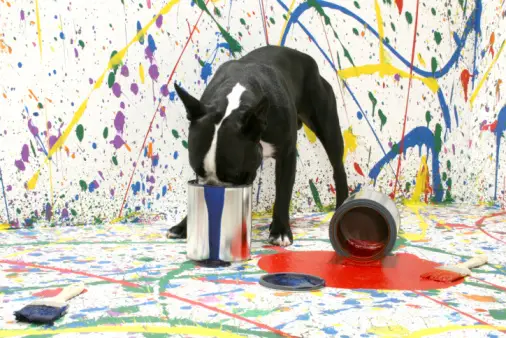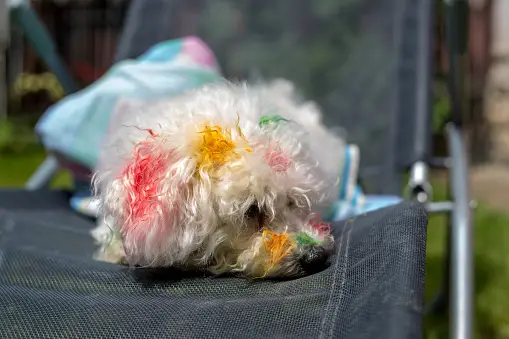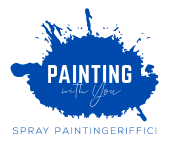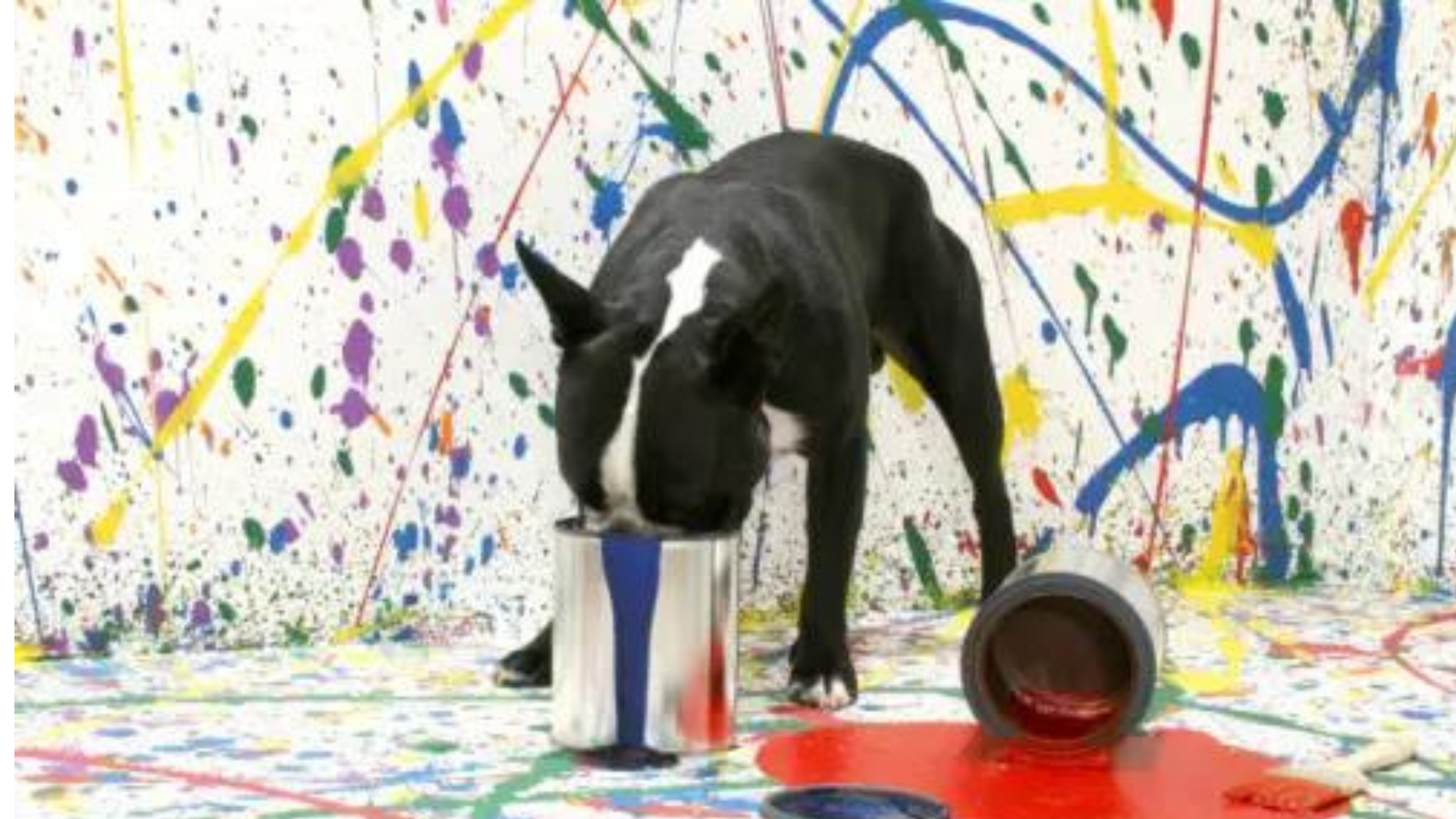As an acrylic painting enthusiast, I love how vibrant and versatile acrylics can be for art and home projects. But ever since getting my puppy Bailey, I’ve started to wonder if those colorful acrylic paints could be dangerous for her to ingest.
If you also use acrylic paint at home and have a canine companion, you may be curious too—is acrylic paint toxic to dogs?
While less hazardous than oil paints, acrylics do contain some potentially concerning ingredients. Let’s take a closer look at the basics of acrylic paint and any possible toxicity risks to our furry friends.

Is Acrylic Paint Toxic If Ingested by Dogs?
Now that we’ve looked at what’s actually in acrylics, how toxic are they if accidentally swallowed by our canine companions? Unfortunately, acrylic paint does pose notable ingestion risks for dogs.
If a dog licked or consumed wet or dry acrylic paint, they are likely to experience gastrointestinal upset, including:
– Nausea, vomiting, drooling
– Abdominal pain
– Loss of appetite
– Diarrhea
Consuming more significant quantities could potentially damage their liver or kidneys over time as heavy metals and solvents are absorbed.
So while a small lap or lick may only cause minor stomach irritation, ingesting larger amounts of paint could be very dangerous to your dog. Let’s go over some tips for safe use and storage.
Safely Using Acrylics in Households with Dogs
With care, we can take steps to use acrylics safely around our furry friends:
– Always keep paints sealed up high when not using them. Never leave open containers unattended.
– Paint in areas your dog can’t access like closed-off rooms; shut doors to minimize odors drifting.
– Avoid painting surfaces your dog could scratch or chew paint from.
– Allow all painted items to fully cure before allowing access. Apply pet-safe sealers when possible.
While not highly lethal in small doses, acrylic paint does demand safety awareness when living with curious canines prone to tasting everything. But with proper precautions, we can mitigate risks.
Symptoms of Paint Poisoning in Dogs
Now that we’ve covered the potential hazards of acrylic paint, let’s discuss the symptoms you may observe if your dog did ingest paint. Recognizing paint poisoning quickly is crucial to get prompt veterinary treatment.
If your dog consumes wet or dry acrylic paint, either through direct ingestion or via grooming paint-covered fur, they are likely to show the following symptoms:
– Pawing at the mouth, drooling, head shaking
– Nausea indicated by lip licking and swallowing
– Vomiting and diarrhea
– Loss of appetite or refusal to eat
– Lethargy, weakness, or collapse
– Abdominal pain
You may also notice abnormal fluid or blood in vomit or stool. Dogs may additionally have tremors or seizures if they absorbed enough toxic heavy metals through the paint.
If you suspect your dog ingested paint, contact your vet or pet poison control right away. Timely treatment improves the prognosis and prevents lasting organ damage. Your vet may induce vomiting to remove any remaining paint before it’s digested.

Storing and Using Paints Cautiously
The best way we can prevent acrylic paint toxicity in dogs is through vigilant safety practices:
Keep All Paints Securely Stored
When not using paints, make sure they are sealed tightly and stored up high or in locked cabinets. Never leave open paint containers unattended, even briefly. Close cans and bottles securely after each use.
Separate Workspaces
Set up painting in areas your dog can’t access, such as a spare room. Close doors and windows to seal off paint vapors. Cover all paint supplies and in-progress artwork when leaving the workspace.
Avoid Painting Dog-Accessible Surfaces
Try not to paint items your dog could reach to mouth or scratch, like low walls or furniture. Dogs may ingest paint if they chew or claw at painted surfaces.
Let Paint Fully Dry and Cure
Allow all painted items to dry thoroughly before letting your dog access them. Apply additional pet-safe sealers on paint when fully cured.
Clean Up Promptly
Wipe up spills immediately with paper towels and wash with soap and water. Double bag paint-coated rags and scraps before discarding.
With planning and rule-following, we can significantly reduce the risk of our dogs accessing hazardous art materials. Next let’s go over some alternative paint choices.
Exploring Dog-Safe Paint Options
If you need guaranteed non-toxic paints for homes with dogs, consider these pet-safe options:
Non-Toxic Acrylic Paint Brands
Some companies specially formulate their acrylic paints to be child-safe and non-toxic when dry, like Krylon K ids’ Paint or Crayola Washable Paints. These avoid hazardous pigments and odorous solvents.
Washable Tempera or Fingerpaint
Look for paints designed for school-age classrooms. Avoid brands with labeling such as “harmful if swallowed.”
Zero-VOC Household Paints
For home decor projects, use low- or zero-VOC acrylic paint formulations from brands like Benjamin Moore. VOCs can irritate respiratory systems.
Always check labels and product information for toxicity guidance before using craft paints around pets. When in doubt, contact the manufacturer.
Here are list of safe acrylic paint for dogs that we found:
| Paint | Brand | Non-Toxic | Safe for Pets | Available at |
|---|---|---|---|---|
| Krylon Kids’ Paint | Krylon | Yes | Yes | Craft stores |
| Crayola Washable Paint | Crayola | Yes | Yes | Craft stores |
| Sargent Art | Sargent Art | Yes | Yes | Craft stores |
| U.S. Art Supply | U.S. Art Supply | Yes | Yes | Online and brick-and-mortar stores |
| Craft Smart Acrylic Paint | Craft Smart | Yes | Yes | Michaels |
| Plaid FolkArt Acrylic Paint | Plaid | Yes | Yes | Craft stores |
| Modern Masters PET Safe Paint | Modern Masters | Yes | Yes | Online and brick-and-mortar stores |
| Benjamin Moore Natura Paint | Benjamin Moore | Yes | Yes | Online and brick-and-mortar stores |
Preventing Paint Exposure in Dogs
Rather than worry about your dog accessing paint, be proactive in prevention:
– Use child-proof or pet-proof trash cans; discarded paint rags can be tempting.
– Avoid leaving artwork, palettes, or cups unattended until thoroughly cleaned.
– When actively painting, keep your dog occupied in another room or crate so they don’t investigate.
– But if your dog licked acrylic paint, try not to totally freak out either. Here’s what I learned about how to handle the situation:
The most important thing is to remain calm and assess how much paint was actually consumed. If your dog just had a minor lick, only a small amount may have been ingested.

In that case, you can just monitor them closely for the next 24 hours for symptoms like appetite changes, vomiting or diarrhea. Just don’t allow any more exposure to paint during this time.
However, if you think your dog licked up a substantial amount of acrylic paint, or you notice symptoms, call your vet right away.
They may advise inducing vomiting to clear any remaining paint out before it’s digested. The quicker the paint is expelled from the body, the less likely it is to cause toxicity issues
With planning and supervision, we can help dogs and paint safely co-exist in our homes. A few fundamental adjustments go a long way to protect pets.
Balancing Creativity and Pet Safety
In summary, acrylic paint does require safety awareness and precaution when living with dogs prone to mouthing behaviors. But with proper handling, storage, and preparation, we can continue enjoying acrylic painting while also keeping our furry companions healthy.
Always put your pet’s wellbeing first, even if it means changing some artistic habits. The good news is small changes often make homes much safer. With care, our pets can inspire our art rather than becoming unintended participants in it!
FAQs
Is acrylic paint toxic to dogs teeth?
Yes, swallowing acrylic paint could be harmful to a dog’s teeth. The paint may stick to the teeth and gums, potentially causing oral irritation, pain, and tooth decay if not properly cleaned off. Avoid letting dogs chew on or ingest paint.
Is acrylic paint toxic to dogs paws?
Wet acrylic paint on a dog’s paws can cause skin irritation, itchiness, or chemical burns if they lick it off before it dries. Dry acrylic paint can also crack and peel on paws, leading to discomfort. It’s best to keep acrylic paint off dog paws entirely.
What paint is safe for dog’s paws?
Non-toxic tempera or finger paints designed for children are safer for dogs’ paws than standard acrylics. You can also apply pet-safe paw wax beforehand as a barrier when finger painting with dogs. Rinse paws off immediately afterward and use pet-safe cleaners if needed.
Is acrylic paint safe for dog paws?
No, it’s best to avoid getting acrylic paint on a dog’s paws. Acrylic paint contains chemicals like ammonia and formaldehyde that could irritate paw pads and cause licking or chewing behaviors. Stick to pet-friendly paints and supervise paint time.
What if my dog eats a small amount of acrylic paint?
Contact your vet, as even small amounts of paint ingested can cause stomach upset. Your vet may recommend inducing vomiting and suggest monitoring for vomiting, diarrhea, appetite changes or lethargy over the next 24 hours. Call poison control if symptoms worsen.
What paint is toxic to dogs?
Oil-based paints are most toxic and dangerous for dogs. But acrylics also contain potentially harmful pigments, solvents and drying agents that could cause poisoning if consumed, especially in large quantities. Always keep all paints stored securely away from pets.

